Improvement of Self-Consumption Rates by Cogeneration and PV Production for Renewable Energy Communities
Abstract
:1. Introduction
2. Materials and Methods
- Self-Consumption Rate (SCR), which indicates the extent to which the electricity generated by local power plants is used within the REC. This also results in a reduced impact on the electricity grid.
- Self-Sufficiency Rate (SSR), which reflects the level of energy independence of the REC. Low SSR values indicate a greater dependence on external—often fossil-based—energy sources.
2.1. The SIMUL-REC Tool
2.2. Calculation Methods and KPIs
- Direct Self-consumption (SCdir): the share of electricity produced by the single PV system and physically used by the user directly connected to the PV system (prosumer user). It corresponds to the minimum between the energy produced (Pi) and the energy consumed (Ci) at any given moment by the single user i. It is the quantity that avoids the need to purchase energy from the grid.
- Shared Energy (SE): the quantity of energy virtually exchanged within the perimeter of the REC; it corresponds to the minimum between the energy fed into the grid (F) and the energy withdrawn from the grid (W) every hour by the group of members involved in the EC. It is the quantity that, while not avoiding the purchase of energy from the grid, allows the energy produced to be exploited locally.
- Total Consumption (Ctot) of the entire REC: can be calculated as the sum of the consumptions of all members of the REC. It corresponds also to the total direct self-consumption plus the total withdrawal of all the members (Ctot = SCdirtot + Wtot).
- Total Production (Ptot) of the entire REC: it can be calculated as the sum of the productions of all members of the REC, and it corresponds also to the total direct self-consumption plus the total injection of all the members (Ptot = SCdirtot + Ftot).
- Total Self-Consumption (SCtot), or the total amount of energy self-consumed locally, within the perimeter of the REC; it is obtained by adding the total direct self-consumptions and the shared energy (SCtot = SCdirtot +SEtot).
- Total Self-Consumption Rates (SCRtot) of the REC:SCRtot = SCtot/Ptot, the ratio between total self-consumption and total production (Ptot) of the community in the considered period. It reflects the degree of local use of energy production.
- Total Self-Sufficiency Rates (SSRtot) of the REC:SSRtot = SCtot/Ctot, the ratio between total self-consumption and total consumption (Ctot) of the community in the considered period. It shows the level of energy independence of the community.
- In particular, considering a period of one day, SCR and SSR can be calculated for every day of the year:SCRtot,day = (SCdirtot,day + SEtot,day)/Ptot,day;SSR tot,day = (SCdirtot,day + SEtot,day)/Ctot,day.
2.3. The REC of Villafranca Padovana
- Electrical production is fed into the grid and sold.
- A large supply of organic waste for the feedstock of the biogas plant is available from the plant owner and nearby companies.
- The heat production is used for heating the livestock farm systems.
3. Results
3.1. REC Main Results
3.2. Seasonality
3.3. The SCR-SSR-PC Curve
3.4. REC Improvement
4. Discussion
- From 0 to 50% CHP. In the first zone, the cogenerator is very useful and significantly increases the Net ZEC, with linear behavior: an additional percentage point of CHP results in a Net ZEC increase of 0.62 points (SCRtot = SSRtot = 0.62x + 41.2, where x represents the mix percentage of CHP).
- From 50% to 75% CHP. In the second zone, the Net ZEC continues to increase linearly, but at a weaker rate: an additional percentage point of CHP results in a Net ZEC increase of 0.42 points (SCRtot = SSRtot = 0.42x + 51.4).
- From 75% to 100% CHP. In the final zone, the results vary slowly, first increasing and then decreasing. The best performance is achieved with 90% biogas and 10% PV, resulting in SCRtot = SSRtot = 84.4%.
5. Conclusions
Author Contributions
Funding
Data Availability Statement
Acknowledgments
Conflicts of Interest
Abbreviations
| CHP | Combined Heat and Power |
| Ctot | Total Consumption |
| EC | Energy Communities |
| Ftot | Total Feed-in |
| GSE | Gestore dei Servizi Energetici (the Italian Energy Services Managing Authority) |
| KPI | Key Performance Indicators |
| LS | Lignano Sabbiadoro |
| Net ZEC | Net Zero Energy Communities |
| Ptot | Total Production |
| PV | Photovoltaic |
| REC | Renewable Energy Communities |
| SC | Self-Consumption |
| SCdir | Direct Self-consumption |
| SCdirtot | Total Direct Self-consumption |
| SCR | Self-Consumption Rate |
| SCRtot | Total Self-Consumption Rate |
| SCtot | Total Self-Consumption |
| SE | Shared Energy |
| SEtot | Total Shared Energy |
| SS | Self-Sufficiency |
| SSR | Self-Sufficiency Rate |
| SSRtot | Total Self-Sufficiency Rate |
| VP | Villafranca Padovana |
| Wtot | Total Withdrawal |
References
- Clean Energy for All Europeans; Publications Office of the European Union: Luxembourg, 2019; ISBN 978-92-79-99835-5. [CrossRef]
- Directive (EU) 2018/2001 of the European Parliament and of the Council of 11 December 2018 on the Promotion of the Use of Energy from Renewable Sources (Recast, PE/48/2018/REV/1). Available online: https://eur-lex.europa.eu/eli/dir/2018/2001/oj/eng (accessed on 12 September 2019).
- Vernay, A.-L.; Sebi, C.; Arroyo, F. Energy community business models and their impact on the energy transition: Lessons learnt from France. Energy Policy 2023, 175, 113473. [Google Scholar] [CrossRef]
- Schwidtal, J.M.; Piccini, P.; Troncia, M.; Chitchyan, R.; Montakhabi, M.; Francis, C.; Gorbatcheva, A.; Capper, T.; Mustafa, M.A.; Andoni, M.; et al. Emerging business models in local energy markets: A systematic review of peer-to-peer, community self-consumption, and transactive energy models. Renew. Sustain. Energy Rev. 2023, 179, 113273. [Google Scholar] [CrossRef]
- Stephant, M.; Abbes, D.; Hassam-Ouari, K.; Labrunie, A.; Robyns, B. Distributed optimization of energy profiles to improve photovoltaic self-consumption on a local energy community. Simul. Model. Pract. Theory 2021, 108, 102242. [Google Scholar] [CrossRef]
- Gianaroli, F.; Ricci, M.; Sdringola, P.; Ancona, M.A.; Branchini, L.; Melino, F. Development of dynamic sharing keys: Algorithms supporting management of renewable energy community and collective self consumption. Energy Build. 2024, 311, 114158. [Google Scholar] [CrossRef]
- Lage, M.; Castro, R.; Manzolini, G.; Casalicchio, V.; Sousa, T. Techno-economic analysis of self-consumption schemes and energy communities in Italy and Portugal. Sol. Energy 2024, 270, 112407. [Google Scholar] [CrossRef]
- Brummer, V. Community energy—Benefits and barriers: A comparative literature review of Community Energy in the UK, Germany and the USA, the benefits it provides for society and the barriers it faces. Renew. Sustain. Energy Rev. 2018, 94, 187–196. [Google Scholar] [CrossRef]
- Tushar, W.; Yuen, C.; Saha, T.K.; Morstyn, T.; Chapman, A.C.; Alam, M.J.E.; Hanif, S.; Poor, H.V. Peer-to-peer energy systems for connected communities: A review of recent advances and emerging challenges. Appl. Energy 2021, 282, 116131. [Google Scholar] [CrossRef]
- Gruber, L.; Bachhiesl, U.; Wogrin, S. The current state of research on energy communities. Elektrotech. Inftech. 2021, 138, 515–524. [Google Scholar] [CrossRef]
- Yiasoumas, G.; Psara, K.; Georghiou, G.E. A review of Energy Communities: Definitions, Technologies, Data Management. In Proceedings of the 2nd International Conference on Energy Transition in the Mediterranean Area (SyNERGY MED), Thessaloniki, Greece, 17–19 October 2022; pp. 1–6. [Google Scholar]
- López, I.; Goitia-Zabaleta, N.; Milo, A.; Gómez-Cornejo, J.; Aranzabal, I.; Gaztañaga, H.; Fernandez, E. European energy communities: Characteristics, trends, business models and legal framework. Renew. Sustain. Energy Rev. 2024, 197, 114403. [Google Scholar] [CrossRef]
- Lazdins, R.; Mutule, A.; Zalostiba, D. PV Energy Communities—Challenges and Barriers from a Consumer Perspective: A Literature Review. Energies 2021, 14, 4873. [Google Scholar] [CrossRef]
- Ceglia, F.; Marrasso, E.; Pallotta, G.; Roselli, C.; Sasso, M. The State of the Art of Smart Energy Communities: A Systematic Review of Strengths and Limits. Energies 2022, 15, 3462. [Google Scholar] [CrossRef]
- Ahmed, S.; Ali, A.; D’Angola, A. A Review of Renewable Energy Communities: Concepts, Scope, Progress, Challenges, and Recommendations. Sustainability 2024, 16, 1749. [Google Scholar] [CrossRef]
- Barabino, E.; Fioriti, D.; Guerrazzi, E.; Mariuzzo, I.; Poli, D.; Raugi, M.; Razaei, E.; Schito, E.; Thomopulos, D. Energy Communities: A review on trends, energy system modelling, business models, and optimisation objectives. Sustain. Energy Grids Netw. 2023, 36, 101187. [Google Scholar] [CrossRef]
- Brown, S.; Jones, D. European Electricity Review 2024; Ember: London, UK, 2024. [Google Scholar]
- Chen, Y.; Guo, M.; Liu, Y.; Wang, D.; Zhuang, Z.; Quan, M. Energy, exergy, and economic analysis of a centralized solar and biogas hybrid heating system for rural areas. Energy Convers. Manag. 2023, 276, 116591. [Google Scholar] [CrossRef]
- Volpato, G.; Carraro, G.; Cont, M.; Danieli, P.; Rech, S.; Lazzaretto, A. General guidelines for the optimal economic aggregation of prosumers in energy communities. Energy 2022, 258, 124800. [Google Scholar] [CrossRef]
- EU Directive 2010/31/UE—European Parliament and Council. 19 May 2010. Available online: https://eur-lex.europa.eu/eli/dir/2010/31/oj/eng (accessed on 7 May 2024).
- Ullah, K.R.; Prodanovic, V.; Pignatta, G.; Deletic, A.; Santamouris, M. Technological advancements towards the net-zero energy communities: A review on 23 case studies around the globe. Sol. Energy 2021, 224, 1107–1126. [Google Scholar] [CrossRef]
- Thrän, D.; Adetona, A.; Borchers, M.; Cyffka, K.F.; Daniel-Gromke, J.; Oehmichen, K. Potential contribution of biogas to net zero energy systems—A comparative study of Canada and Germany. Biomass Bioenergy 2025, 193, 107561. [Google Scholar] [CrossRef]
- Calise, F.; Cappiello, F.L.; Cimmino, L.; Vicidomini, M. A Dynamic Analysis of Biomethane Reforming for a Solid Oxide Fuel Cell Operating in a Power-to-Heat System Integrated into a Renewable Energy Community. Energies 2024, 17, 3160. [Google Scholar] [CrossRef]
- Al-Najjar, H.; Pfeifer, C.; Al Afif, R.; El-Khozondar, H.J. Performance Evaluation of a Hybrid Grid-Connected Photovoltaic Biogas-Generator Power System. Energies 2022, 15, 3151. [Google Scholar] [CrossRef]
- Ceglia, F.; Marrasso, E.; Roselli, C.; Sasso, M.; Coletta, G.; Pellegrino, L. Biomass-Based Renewable Energy Community: Economic Analysis of a Real Case Study. Energies 2022, 15, 5655. [Google Scholar] [CrossRef]
- Tamoor, M.; Bhatti, A.R.; Hussain, M.I.; Miran, S.; Kiren, T.; Ali, A.; Lee, G.H. Optimal sizing and technical assessment of a hybrid renewable energy solution for off-grid community center power. Front. Energy Res. 2023, 11, 1283586. [Google Scholar] [CrossRef]
- Ministero dell’Ambiente e della Sicurezza Energetica—Monitoraggio PNIEC. Available online: https://www.pniecmonitoraggio.it/Dimensioni/Rinnovabili/FER%20Elettriche/Pagine/Incentivi-e-altre-misure.aspx#CACER (accessed on 20 February 2025).
- TERNA, Dati Statistici Sull’energia Elettrica in Italia 2023. Available online: https://www.terna.it/it/sistema-elettrico/statistiche/pubblicazioni-statistiche (accessed on 7 May 2024).
- GSE, Rapporto Statistico Fotovoltaico 2023—Solare Fotovoltaico. May 2024. Available online: https://www.gse.it/dati-e-scenari/statistiche (accessed on 15 May 2024).
- Branchetti, S.; Petrovich, C.; Naldi, R.; Paponetti, I.M.; Paolucci, F.; Nigliaccio, G. PV Self-Consumption and Self-Sufficiency for Household and Office Users: The Lockdown Effects During the COVID-19 Pandemic. Int. J. Sustain. Dev. Plan. 2022, 17, 2–659. [Google Scholar] [CrossRef]
- Vecchi, F.; Berardi, U. Mixed-use neighbourhood to maximise urban energy community potential. E3S Web Conf. 2024, 523, 05002. [Google Scholar] [CrossRef]
- Mutani, G.; Santantonio, S.; Beltramino, S. Indicators and Representation Tools to Measure the Technical-Economic Feasibility of a Renewable Energy Community. The Case Study of Villar Pellice (Italy). Int. J. Sustain. Dev. Plan. 2021, 16, 1. [Google Scholar] [CrossRef]
- Petrovich, C.; Branchetti, S.; D’Agosta, G. Parametrization of self-consumption and self-sufficiency in Renewable Energy Communities: A case study application. Energy Ecol. Environ. 2025. [Google Scholar] [CrossRef]
- Simoiu, M.S.; Fagarasan, I.; Ploix, S.; Calofir, V. Sizing and Management of an Energy System for a Metropolitan Station with Storage and Related District Energy Community. Energies 2021, 14, 5997. [Google Scholar] [CrossRef]
- Todeschi, V.; Marocco, P.; Mutani, G.; Lanzini, A.; Santarelli, M. Towards energy self-consumption and self-sufficiency in urban energy communities. Int. J. Heat Technol. 2021, 39, 1–11. [Google Scholar] [CrossRef]
- Cutore, E.; Volpe, R.; Sgroi, R.; Fichera, A. Energy management and sustainability assessment of renewable energy communities: The Italian context. Energy Convers. Manag. 2023, 278, 116713. [Google Scholar] [CrossRef]
- Cosic, A.; Stadler, M.; Mansoor, M.; Zellinger, M. Mixed-integer linear programming based optimization strategies for renewable energy communities. Energy 2021, 237, 121559. [Google Scholar] [CrossRef]
- Gribiss, H.; Aghelinejad, M.M.; Yalaoui, F. Configuration Selection for Renewable Energy Community Using MCDM Methods. Energies 2023, 16, 2632. [Google Scholar] [CrossRef]
- Luthander, R.; Widén, J.; Nilsson, D.; Palm, J. Photovoltaic self-consumption in buildings: A review. Appl. Energy 2015, 142, 80–94. [Google Scholar] [CrossRef]
- Braeuer, F.; Kleinebrahm, M.; Naber, E.; Scheller, F.; McKenna, R. Optimal system design for energy communities in multi-family buildings: The case of the German tenant Electricity Law. Appl. Energy 2022, 305, 117884. [Google Scholar] [CrossRef]
- Schito, E.; Taverni, L.; Conti, P.; Testi, D. Optimization of the composition of residential buildings in a renewable energy community based on monitored data. Optim. Eng. 2024. [Google Scholar] [CrossRef]
- Xiao, J.; Yang, Y.; Cui, S.; Liu, X. A new energy storage sharing framework with regard to both storage capacity and power capacity. Appl. Energy 2022, 307, 118171. [Google Scholar] [CrossRef]
- Li, L.; Zhang, S.; Cao, X.; Zhang, Y. Assessing economic and environmental performance of multi-energy sharing communities considering different carbon emission responsibilities under carbon tax policy. J. Clean. Prod. 2021, 328, 129466. [Google Scholar] [CrossRef]
- Weckesser, T.; Dominković, D.F.; Blomgren, E.M.V.; Schledorn, A.; Madsen, H. Renewable Energy Communities: Optimal sizing and distribution grid impact of photo-voltaics and battery storage. Appl. Energy 2021, 301, 117408. [Google Scholar] [CrossRef]
- Ebrahimi, M. Storing electricity as thermal energy at community level for demand side management. Energy 2020, 193, 116755. [Google Scholar] [CrossRef]
- Derakhshan, G.; Shayanfar, H.A.; Kazemi, A. The optimization of demand response programs in smart grids. Energy Policy 2016, 94, 295–306. [Google Scholar] [CrossRef]
- GSE. GRUPPI DI AUTOCONSUMATORI DI ENERGIA RINNOVABILE CHE AGISCONO COLLETTIVAMENTE E COMUNITÀ DI ENERGIA RINNOVABILE, Modalità di profilazione dei dati di misura e relative modalità di utilizzo ai sensi dell’articolo 9 dell’Allegato A alla Delibera 318/2020/R/eel, Versione n. 1—04/04/2022. Available online: https://www.gse.it/servizi-per-te/autoconsumo/gruppi-di-autoconsumatori-e-comunita-di-energia-rinnovabile/documenti (accessed on 5 December 2023).
- Branchetti, S.; Petrovich, C.; Nigliaccio, G.; Paolucci, F. The Lockdown and Smart Working Effects on Electric Energy Consumption: The Analysis For A Group Of Employees. TECNICA ITALIANA-Ital. J. Eng. Sci. 2021, 65, 2–292. [Google Scholar] [CrossRef]
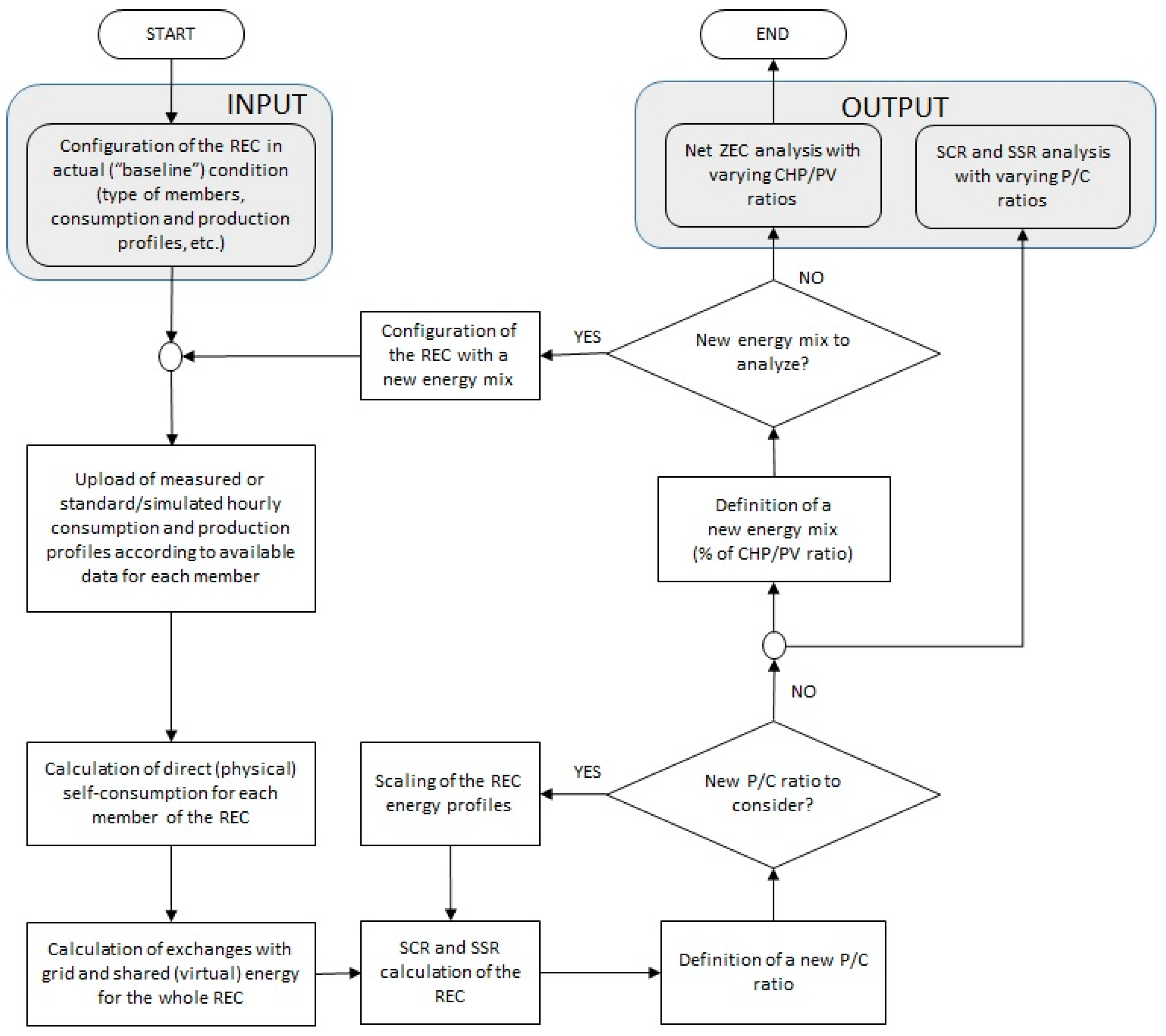

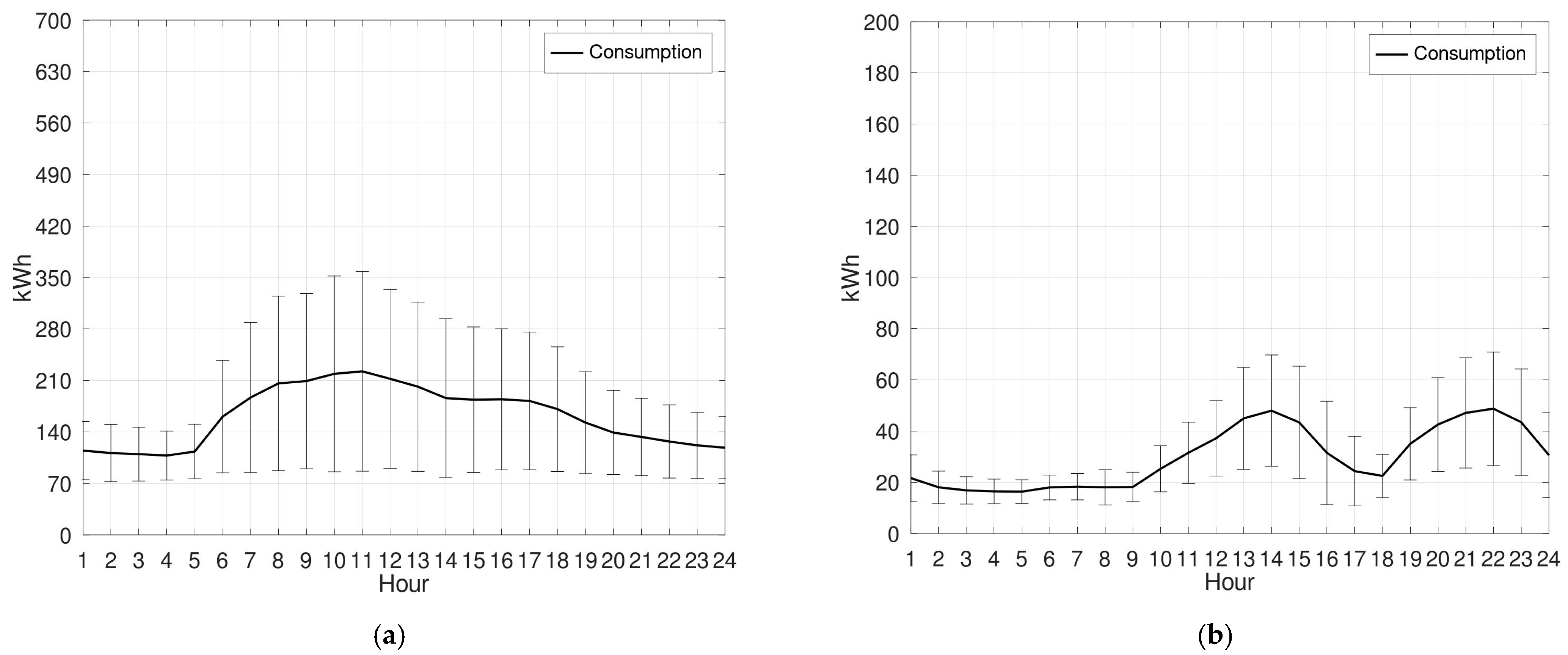


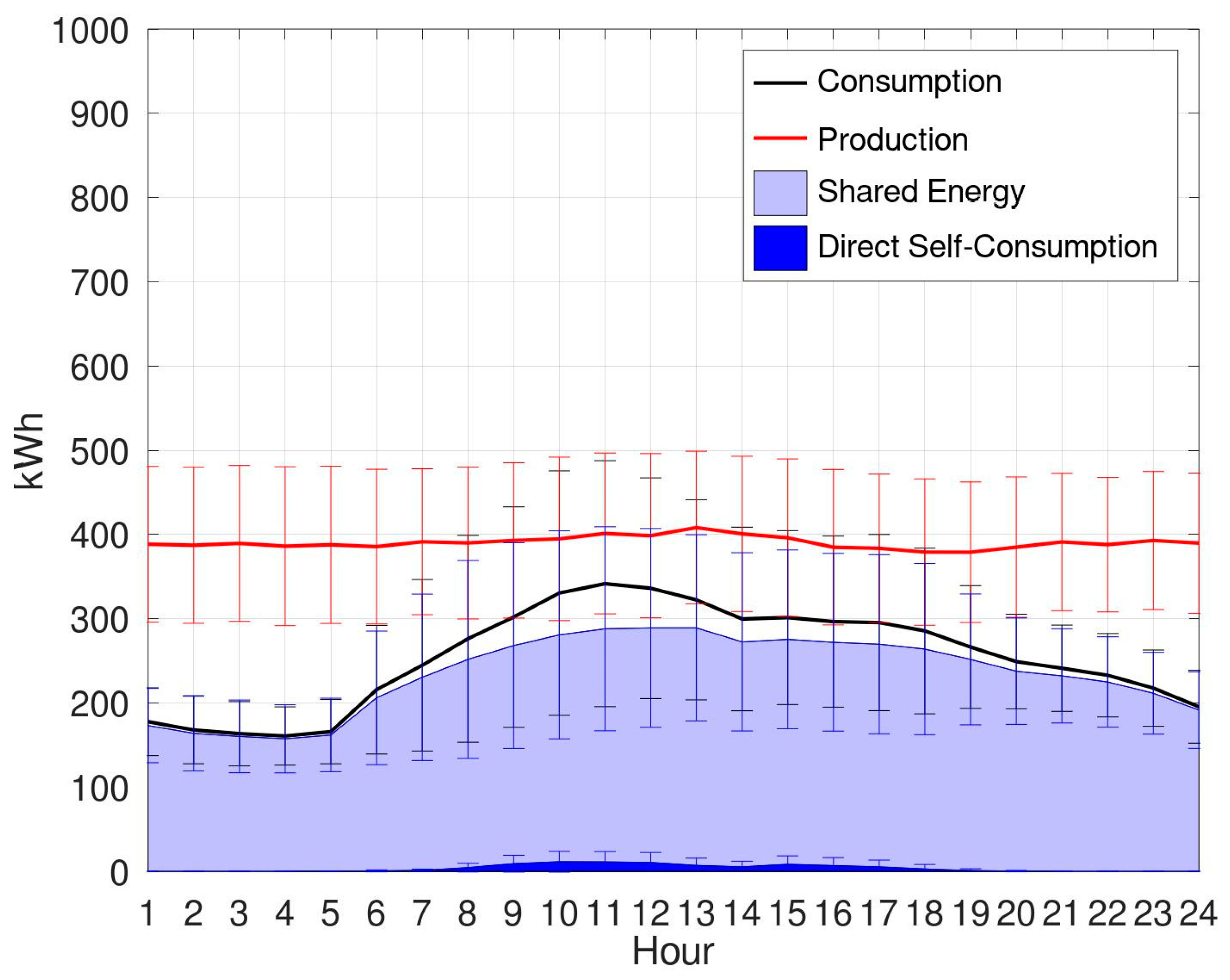

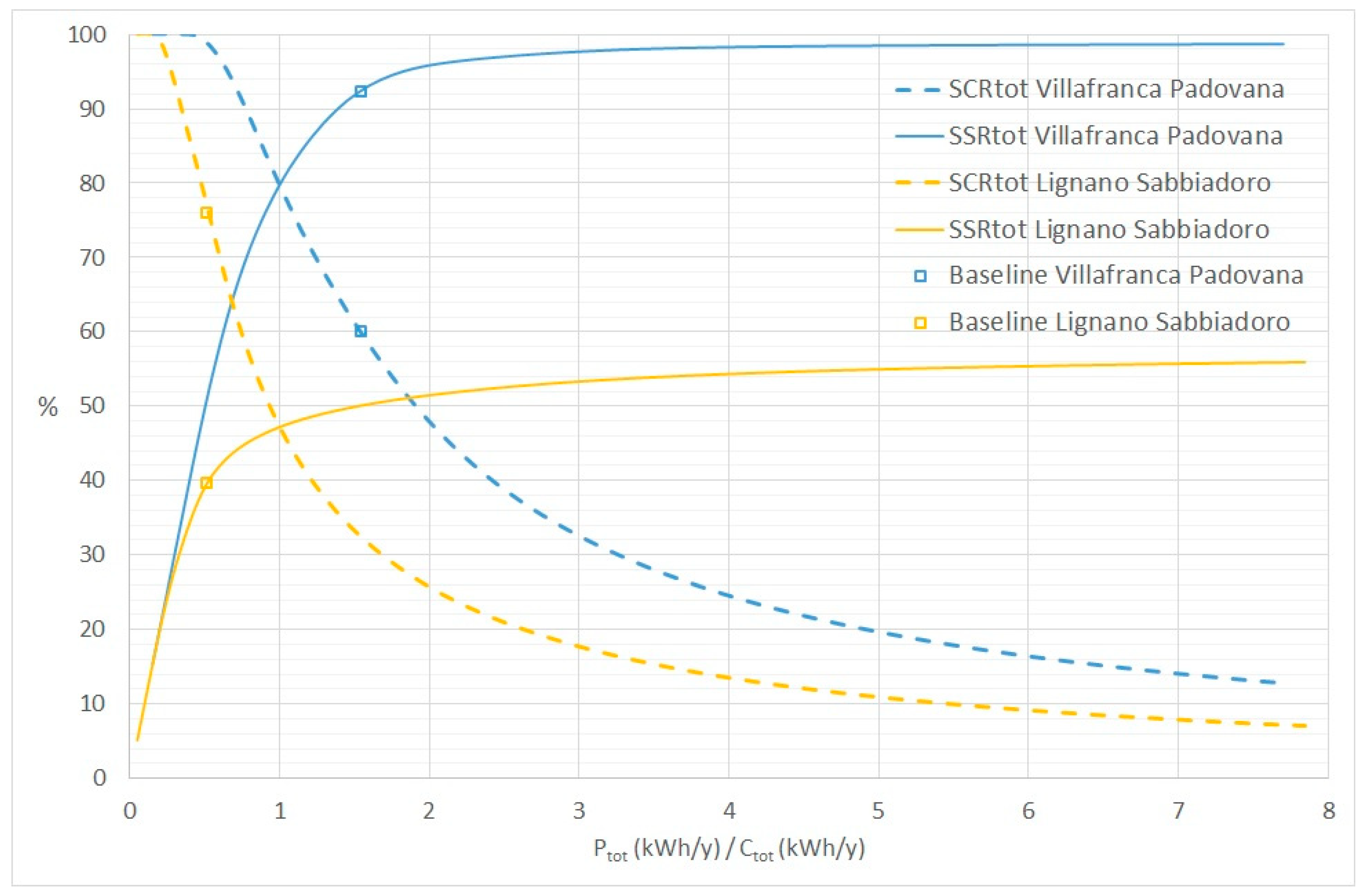
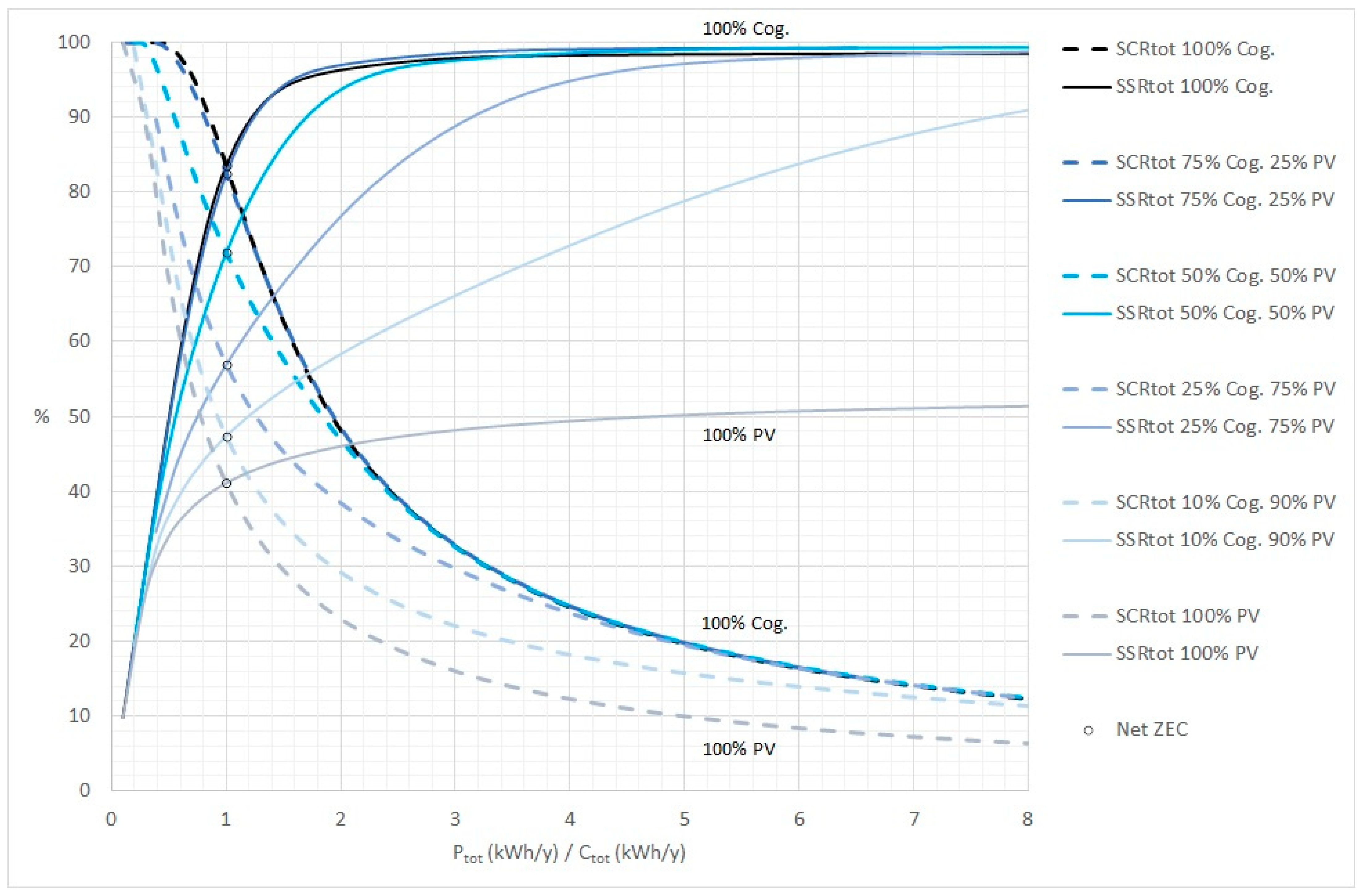
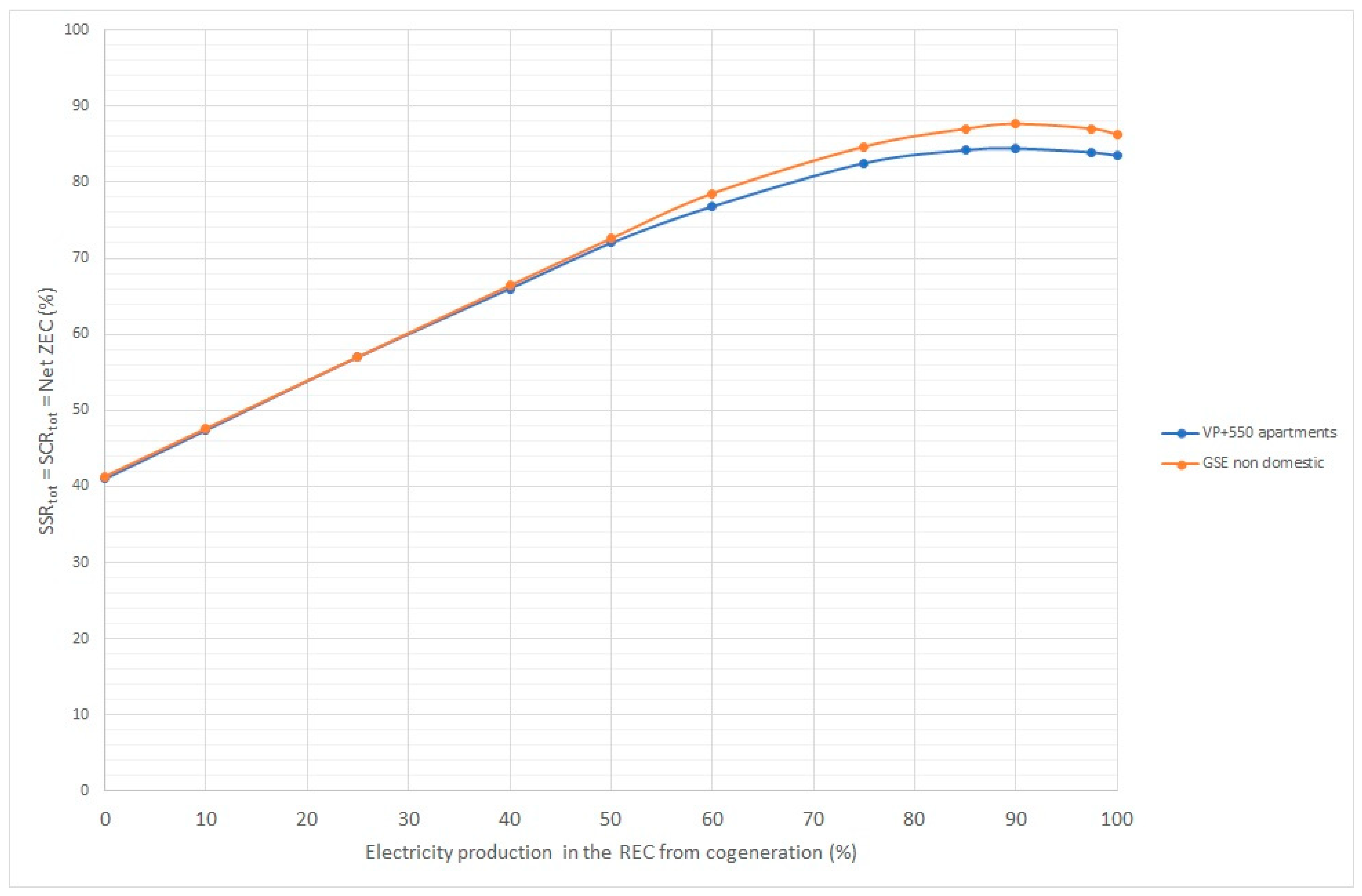

| Algorithm | Reference |
|---|---|
| MILP (Mixed-Integer Linear Programming) | [37,40] |
| Genetic optimization | [41] |
| ADMM (Alternating Direction Method of Multipliers) | [42,43] |
| Linear Programming | [44] |
| Particle Swarm Optimisation | [45] |
| TLBO (Teaching & Learning based Optimization) | [46] |
| Types of Users | Quantity of Utilities | Consumption MWh | Production MWh | Power kW |
|---|---|---|---|---|
| Consumer-only | 51 | 2135 | - | - |
| Producer | 1 | - | 3346 | 500 |
| Prosumer 1 | 1 | 92 | 84 | 64.5 |
| Total | 53 | 2227 | 3430 | 564.5 |
| Categories of Utilities | Quantity of Utilities | Consumption | Power |
|---|---|---|---|
| Companies | 11 | 89% | 564.5 kW |
| Residential | 21 | 3% | - |
| Municipal | 21 | 8% | - |
| Total | 53 | 100% | 564.5 kW |
| Rate | KPI | Calculated Value |
|---|---|---|
| Self-Consumption | SCRtot = (SCdirtot + SEtot)/Ptot | 60.0% |
| Self-Sufficiency | SSRtot = (SCdirtot + SEtot)/Ctot | 92.4% |
| REC Configuration | Production | Consumption | Baseline Condition (Ptot/Ctot Ratio) | Net ZEC (Ptot/Ctot = 1) |
|---|---|---|---|---|
| Lignano Sabbiadoro (LS) | 0% Cogen. | Profile of LS REC | 0.52 | 47% |
| 100% PV | in baseline condition | |||
| Villafranca Padovana (VP) | 97.5% Cogen. | Profile of VP REC | 1.54 | 80% |
| 2.5% PV | in baseline condition | |||
| VP with only PV production * | 0% Cogen. 100% PV | Profile of VP REC | 0.62 | 42% |
| REC Configuration | Production | Consumption | Simulated Condition (Ptot/Ctot Ratio) | Net ZEC (Ptot/Ctot = 1) |
|---|---|---|---|---|
| VP with addition of 550 apartments | 97.5% Cogen. | Profile of VP REC | 1.00 | 83.9 |
| 2.5% PV | + 550 apartments | |||
| VP with addition of 550 apartments and PV (64.5 + 220 = 284.5 kWp) | 90% Cogen. | Profile of VP REC | 1.08 | 84.4 |
| 10% PV | + 550 apartments |
Disclaimer/Publisher’s Note: The statements, opinions and data contained in all publications are solely those of the individual author(s) and contributor(s) and not of MDPI and/or the editor(s). MDPI and/or the editor(s) disclaim responsibility for any injury to people or property resulting from any ideas, methods, instructions or products referred to in the content. |
© 2025 by the authors. Licensee MDPI, Basel, Switzerland. This article is an open access article distributed under the terms and conditions of the Creative Commons Attribution (CC BY) license (https://creativecommons.org/licenses/by/4.0/).
Share and Cite
Branchetti, S.; Petrovich, C.; Gessa, N.; D’Agosta, G. Improvement of Self-Consumption Rates by Cogeneration and PV Production for Renewable Energy Communities. Electronics 2025, 14, 1755. https://doi.org/10.3390/electronics14091755
Branchetti S, Petrovich C, Gessa N, D’Agosta G. Improvement of Self-Consumption Rates by Cogeneration and PV Production for Renewable Energy Communities. Electronics. 2025; 14(9):1755. https://doi.org/10.3390/electronics14091755
Chicago/Turabian StyleBranchetti, Samuele, Carlo Petrovich, Nicola Gessa, and Gianluca D’Agosta. 2025. "Improvement of Self-Consumption Rates by Cogeneration and PV Production for Renewable Energy Communities" Electronics 14, no. 9: 1755. https://doi.org/10.3390/electronics14091755
APA StyleBranchetti, S., Petrovich, C., Gessa, N., & D’Agosta, G. (2025). Improvement of Self-Consumption Rates by Cogeneration and PV Production for Renewable Energy Communities. Electronics, 14(9), 1755. https://doi.org/10.3390/electronics14091755






